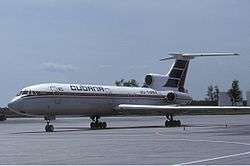Cubana de Aviación Flight 389
 A Cubana Tu-154 similar to the one involved seen here in 1985 at Montréal-Mirabel International Airport | |
| Accident | |
|---|---|
| Date | 29 August 1998 |
| Summary | Pilot error |
| Site | Near Mariscal Sucre International Airport, Quito, Pichinca province, Ecuador |
| Aircraft | |
| Aircraft type | Tupolev Tu-154M |
| Operator | Cubana de Aviación |
| Registration | CU-T1264 |
| Flight origin | Mariscal Sucre International Airport, Quito, Ecuador |
| Destination | Simón Bolívar International Airport, Guayaquil, Ecuador |
| Passengers | 77 |
| Crew | 14 |
| Fatalities | 80 (including 10 on the ground) |
| Injuries | 39 |
| Survivors | 21 |
Cubana de Aviación Flight 389 (CU389/CUB389) was a scheduled domestic passenger flight, flying from Mariscal Sucre International Airport in Quito to Simón Bolívar International Airport (currently renamed as José Joaquín de Olmedo International Airport) in Guayaquil, operated by Cuban flag carrier Cubana de Aviación. On 29 August 1998, the aircraft operating the flight, a Tupolev Tu-154M overran the runway, smashing buildings and crashed into a soccer field in Quito while taking off from the airport. The aircraft burst into flames and 70 people on board were killed. A total of 10 people on the ground, including children, were killed.[1]
Investigation committee conducted by the Ecuadorian Dirección General de Aviación Civil, concluded that the crash was caused due to mechanical failure that led to an aborted take off. The crew forgot to select the switches for the hydraulic valves of the control system. While rolling for take-off, the plane didn't rotate. A rejected take off occurred and Flight 389 overran the runway. The crash remains as the second deadliest crash in Ecuador, after a Boeing 737-200 crashed in Cuenca in 1983.[2]
Accident
Flight 389 was preparing for departure. During the first engine start, a pneumatic valve was blocked. The problem was rectified and two engines were started with ground power. During its taxi, the third engine was started. Flight 389 later obtained their take-off clearance and started their roll. The first and the second take-off attempt failed. It then attempted its third take off. When Flight 389 reached Vr speed, the aircraft nose of the aircraft wouldn't lift (rotate). The brakes were applied, however, it didn't pay off. The aircraft overran the runway, narrowly missed the heavily traveled avenue at the end of the airport runway in a middle-class residential neighborhood, slammed a wall, clipped an auto mechanic shop, smashed into two houses and plowed into a soccer field. At the time, many people including children were playing on the field. The aircraft exploded and burst into flames [3]
Rescuers reached the crash site and started to evacuate survivors from the crash site. Explosions could be heard repeatedly after the crash. Firefighters jets of water on the smoking ruins to prevent additional explosions and local authorities cordoned off the crash site and searched for amissing local resident. Many people on the ground went missing in the crash. A mother stated that her three children were missing after the crash. 26 injured people were rushed to three hospitals, with 15 of them onto the Quito Metropolitan Hospital. Survivors stated that some doors on the plane wouldn't open after impact and several survivors escaped from the fiery wreckage through a hole in the fuselage. Several people jumped on the plane while they were on fire. On Sunday, 30 August, Ecuadorian Red Cross stated that as many as 77 badly burned bodies have been recovered from the crash site. Five children playing on the field were killed as the plane plowed onto them.[4]
Aircraft, passengers and crews
The aircraft was a Tupolev Tu-154M, serial number 85A720 and registered in Cuba as CU-T1264. The aircraft was carrying 91 people, consisting of 14 crew and 77 passengers. Most of the occupants were Ecuadorians, with some Argentinians, Italians, Jamaicans, Chileans and Cubans.[5][6]
Aftermath
Shortly after the crash, Mariscal Sucre International Airport was closed and every flight operations were cancelled in response to the crash. Ecuadorian President Jamil Mahuad visited the crash site and expressed his solidarity to the next of kin and relatives of the victims of the crash. He ordered a full report into the cause of the crash and stated that he would build a new airport away from the city. The present site had been criticised for being too close to a densely populated area. A Red Cross workers stated that the accident was evidence of the riskiness of the airport situated in the northern part of the Andean city in a highly populated zone.[7]
See also
References
- ↑ "World: Americas - Dozens dead in Ecuador crash". BBC. 30 August 1998.
- ↑ "Accident description".
- ↑ "SCORES KILLED AS CUBAN JET CRASHES IN ECUADOR". The Washington Post.
- ↑ "Dozens dead in Ecuador crash". BBC.
- ↑ https://www.nytimes.com/1998/08/30/world/77-die-in-crash-of-cuban-jet-in-ecuador.html
- ↑ https://www.planelogger.com/Aircraft/Registration/CU-T1264/801074
- ↑ "Cuban airliner crashes in Ecuador". SFGate.